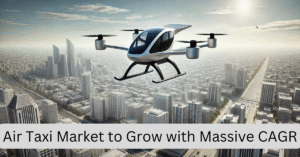The future of air taxis looks promising, with growing investments, supportive policies, and continuous innovation. Public perception and regulatory approvals will be crucial for success.
The Air Taxi Market Outlook points toward rapid commercialization in select cities by the late 2020s. Early operational hubs will set benchmarks for safety, efficiency, and affordability. As the market matures, air taxis could revolutionize urban mobility, offering a sustainable and time-saving alternative to road travel.

The market represents a revolutionary leap in urban and regional transportation, driven by the growing need to reduce road congestion and improve commuter efficiency. Air taxis, typically defined as electric vertical take-off and landing (eVTOL) aircraft or small fixed-wing planes, are designed to carry passengers over short distances, either on-demand or via scheduled services. As urban populations rise and road infrastructure strains under increasing traffic, air taxis offer a promising solution for fast, clean, and efficient travel.
As of 2024, the global air taxi market is valued at approximately USD 800 million, with projections to exceed USD 10 billion by 2032, growing at a CAGR of over 30%. Technological advancements, government support for sustainable transport, and growing investor interest are fueling this growth.
Market Overview
Air taxis fall under the umbrella of Urban Air Mobility (UAM), a new aviation concept that integrates aerial transport into metropolitan ecosystems. These aircraft are often electrically powered, autonomous or semi-autonomous, and designed for short-haul flights ranging from 20 to 300 kilometers. While commercial operations are still in early stages, several companies are actively developing prototypes, securing regulatory approvals, and partnering with cities and aviation authorities.
Applications include intra-city passenger transport, airport transfers, emergency services, and even cargo delivery. With reduced noise, zero emissions, and high operational efficiency, air taxis are positioned as a clean alternative to traditional helicopters and ground-based taxis.
Key Market Trends
- Emergence of eVTOL Aircraft
Electric Vertical Take-Off and Landing (eVTOL) aircraft are at the heart of the air taxi revolution. These aircraft combine the vertical lift capability of helicopters with the speed and range of fixed-wing planes, all while offering reduced maintenance costs and quieter operations. Companies like Joby Aviation, Lilium, and Archer Aviation are pioneering this space.
- Autonomous and Semi-Autonomous Operations
Advanced navigation systems, AI, and sensor technologies are enabling semi-autonomous and fully autonomous flight capabilities. These innovations are expected to enhance safety, reduce pilot training costs, and eventually allow unmanned passenger flights.
- Sustainable Urban Transportation
With increasing pressure to reduce carbon emissions, air taxis powered by electric propulsion systems offer an eco-friendly alternative. Cities aiming for net-zero targets are encouraging investments in electric aviation infrastructure, including vertiports and charging stations.
- Growing Investment and Partnerships
The air taxi ecosystem is attracting significant venture capital and private equity funding. Partnerships between aviation firms, automotive companies, ride-hailing platforms (like Uber and Lyft), and municipalities are accelerating development. For example, Hyundai has partnered with Supernal for eVTOL production, and Delta Airlines has invested in Joby Aviation.
- Regulatory Progress
Aviation authorities such as the FAA (U.S.) and EASA (Europe) are actively working on airworthiness certifications and airspace integration frameworks. While commercial operations are expected by 2025 in select regions, regulatory clarity remains a key enabler for the market.
Market Segmentation
By Type
eVTOL Aircraft: Dominating the segment due to flexibility, quiet operation, and reduced emissions.
Conventional Helicopters and STOL Aircraft: Still relevant in early-phase services or in regions lacking eVTOL infrastructure.
By Mode of Operation
Autonomous: Expected to grow rapidly post-2030 as technology matures and public acceptance increases.
Piloted: Currently preferred for safety and regulatory compliance.
By End Use
Passenger Transport: Primary application in urban commuting, airport shuttles, and tourism.
Cargo and Logistics: Used for last-mile deliveries, especially in congested or remote areas.
Emergency Services: Air ambulances, disaster relief, and urgent deliveries of medical supplies.
By Range
20–100 km: Most common use case for urban transfers.
100–300 km: Suitable for intercity or regional connectivity.
Regional Insights
North America
North America is the global leader in air taxi development, led by the United States. Favorable government policies, a mature aviation ecosystem, and significant private investments support growth. Companies like Joby Aviation, Archer Aviation, and Wisk Aero are conducting flight trials. The FAA is actively working on regulatory frameworks to enable commercial operations by 2025.
Europe
Europe is also advancing rapidly, with Germany, France, and the UK leading eVTOL innovation. Lilium (Germany) and Volocopter (Germany) are two major players developing electric air taxis for urban applications. The European Union Aviation Safety Agency (EASA) is pioneering airworthiness standards and urban air mobility integration with local governments.
Asia-Pacific
The Asia-Pacific region shows high growth potential, especially in densely populated urban centers such as Tokyo, Seoul, Mumbai, and Singapore. Japan has announced plans for air taxi services at the 2025 Osaka World Expo, while South Korea and China are investing heavily in UAM ecosystems. China’s EHang has already conducted autonomous passenger drone flights.
Middle East & Africa
The Middle East is emerging as a hub for futuristic transport. Dubai, known for its smart city initiatives, has partnered with firms like Joby and Volocopter for pilot programs. Saudi Arabia’s NEOM project also includes UAM elements. In Africa, although in early stages, air taxis could offer mobility in areas with poor infrastructure.
Latin America
Latin America presents opportunities in metropolitan cities such as São Paulo and Mexico City, where traffic congestion is severe. While infrastructure is limited, the region could benefit from affordable, point-to-point aerial services in the future.
Key Players
Joby Aviation (USA): Leading eVTOL developer targeting commercial operations in 2025 with support from Delta Airlines.
Volocopter (Germany): Developing multi-rotor air taxis for urban use, with pilot programs in Singapore and Dubai.
Lilium (Germany): Focused on regional air mobility with fixed-wing electric aircraft and long-range capabilities.
Archer Aviation (USA): Developing the Midnight eVTOL, with backing from United Airlines.
EHang (China): A pioneer in autonomous aerial vehicles, already conducting passenger drone trials in multiple countries.
Wisk Aero (USA): Backed by Boeing, focusing on autonomous air taxi solutions.
Market Challenges
- Regulatory Hurdles
Certification of airworthiness, pilot training standards, and airspace management are still evolving. Delays in regulatory approvals could impact commercial rollouts.
- Infrastructure Development
Air taxis require vertiports, charging stations, and air traffic control integration. Building this infrastructure in dense urban environments is a complex and expensive task.
- Safety and Public Acceptance
Passenger safety, noise concerns, and fear of autonomous flights remain key barriers. Demonstrating safety and reliability will be crucial for market adoption.
- High Development Costs
R&D, prototyping, and testing of eVTOLs require substantial investment. Many startups are dependent on sustained funding and long-term partnerships.
- Battery Technology Limitations
Current battery technologies limit flight time and payload. Improvements in energy density, charging speed, and battery life are essential for scalable operations.
Future Outlook
The air taxi market holds transformative potential for the future of urban mobility. As technology advances and regulatory pathways become clearer, commercial services are expected to launch in select cities by 2025–2026, with broader adoption by 2030. Integration with ground transport systems, smart city infrastructure, and renewable energy grids will enhance the appeal and sustainability of air taxis.
In the long term, air taxis could become a mainstream mobility option, reducing commute times, emissions, and urban congestion. With continued innovation, investment, and public engagement, the skies may become the highways of the future.


